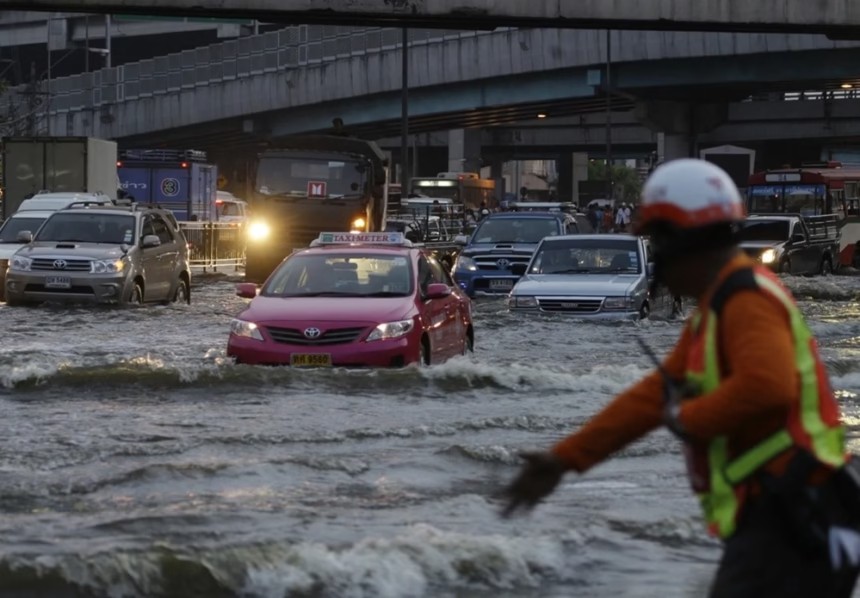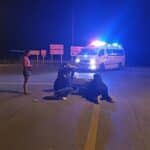BANGKOK — Intense late-night rain pummelled the capital on Sunday, submerging roads, stalling cars, and testing patience across the city. By midday Monday, most water had drained away, yet pockets of flooding in low-lying areas kept emergency crews busy and reignited calls for stronger flood defenses and better planning.
A low-pressure trough crossing upper Thailand set off the downpour, dumping up to 131.5 millimeters in a few hours. The storm unloaded more than twice the city’s drainage design of 60 millimeters.
Governor Chadchart Sittipunt, who directed operations from the Bangkok Flood Control Operations Center in Din Daeng, said the scale of flooding reflected multiple pressures, including roadworks and seasonal high tides, not just the rain itself.
He said overnight crews did all they could and pushed for long-term investment to reduce repeat incidents.
Northern and eastern districts bore the brunt. Canals and underpasses spilled over as runoff surged. Lak Si, which includes the Government Complex on Chaeng Watthana Road, saw the heaviest rain. Main routes such as Vibhavadi Rangsit Road turned into moving streams.
Residents described bikes slipping through knee-deep water, high-end cars left at junctions, and families wading home with shopping held above their heads.
By 5 am on Monday, the Bangkok Metropolitan Administration reported 5 to 20 centimeters of water across 18 districts. These included Don Mueang, Bang Sue, Lat Krabang, Sai Mai, Chatuchak, Din Daeng, Lat Phrao, Wang Thonglang, Watthana, Huai Khwang, Bang Khen, Prawet, Bang Rak, Bang Kapi, Suan Luang, and Khlong Toey. A flooded underpass in Bang Sue went viral as commuters posted clips of stranded vehicles and tailbacks.
In Don Mueang, Song Prapha Road stayed closed well into the afternoon. Officials sent pumps to move water into nearby canals. Taxi driver Somchai Boonmee, 52, said he abandoned his car around midnight and spent hours making detours.
On Nut Soi 59 in Prawet, I saw similar scenes, with construction work worsening, pooling in side streets. The BMA’s live flood map on the Traffy Fondue app logged more than 200 complaints by noon. Local volunteers handed out sandbags and drinking water in hard-hit sois.
Outlying Provinces Hit, From Samut Prakan to Pattaya
Flood impacts stretched beyond Bangkok, showing how Greater Bangkok shares water risks. In Samut Prakan’s Phraekasa area, roads such as Phuttaraksa sat under 30 centimeters of brown floodwater overnight.
At least 13 schools, among them Assumption Samut Prakan, Debsirin Samut Prakan, and Saint Joseph Bangna, closed on Monday and switched to online classes while playgrounds and access roads were still inundated.
Ratwinit Bangkaeo School’s principal, Supaporn Chaisri, said anxious parents called through the night, and that keeping pupils off-site was the only safe choice. Srinagarindra Road, an important route to Suvarnabhumi Airportwas clogged for hours, which delayed staff and disrupted journeys.
Pattaya in Chon Buri also faced flash floods. Low stretches of Pattaya 3 Road became impassable for small cars. Beach visitors helped move residents, with long-tail boats ferrying people through waist-deep water. The Thai Meteorological Department linked the flooding to the same trough and warned of isolated heavy rain through Friday.
In Nonthaburi and Pathum Thani, riverside communities along the Chao Phraya stayed on watch for tidal surges, with Pakkret on alert. Governor Chadchart worked with the Royal Irrigation Department to open floodgates and send excess water towards the Gulf of Thailand.
Closures and Disruptions Across the City
The floods set off widespread disruption. The Bangkok Remand Prison in Chatuchak paused all visits, legal meetings, and court transfers due to ankle-deep water in service areas, promising to reschedule once conditions improved.
Traffic chiefs warned drivers about more than 50 affected routes, including Prachachuen-Leiab Klong Prakhan Road, where pre-dawn visibility was near zero. The Expressway Authority of Thailand shut inbound sections of the Chalong Rat Expressway near Don Mueang, forcing detours and adding up to two hours to commutes.
Schools reopening after the holiday faced delays in flood-hit districts. At Chatuchak Weekend Market, traders secured stalls and stock as a precaution. Public transport kept running, but BTS and MRT operators advised passengers to check apps for signal delays on water-affected tracks.
No serious injuries were reported. The BMA hotline, 1555, took hundreds of calls from stranded motorists, and rescue teams towed more than 150 vehicles by evening.
On the Ground, Grit and Community Spirit
For many, the scenes felt all too familiar. Noi Arun, 68, in Bang Sue, said each rainy season brings the same cycle of water creeping in, water draining out, and new promises to fix it. Even so, neighbors teamed up to share pumps, and food stalls handed out free khao man gai to clean-up crews and volunteers.
Young residents turned social channels into support networks. A viral post from the Bangkok Flood Fighters group urged people to share locations for help, and roughly 200 volunteers were mobilized by midday.
Specialists warned that frequent flooding points to deeper structural problems. Dr Sonthi Kotchawat from the Thai Environmental Scholars Association called for a comprehensive fix. He cited land subsidence of about 1 centimeter per year, blocked canals, and heavier rains linked to climate patterns. He argued that Bangkok sits on a sinking delta and needs a fast, reliable path for water to reach the sea.
The BMA’s 2025 flood budget totals 90 billion baht, with 8 billion for pumps and retention basins. Critics say the plan is fragmented. Governor Chadchart promised a mid-November review and said the city is studying overseas models such as Venice’s MOSE barriers.
As of Tuesday morning, the TMD put the chance of thundershowers at 70 percent for Bangkok and nearby provinces, easing towards the weekend. High tides along the Chao Phraya could keep minor pooling in some areas, but officials said the worst has passed.
For now, pumps continue to whirr as waterlines fall and traffic starts moving again. Chadchart said building a city that can cope with future storms will take more than quick drainage. In a city of 10 million, where floods cost billions each year, the push for lasting solutions now feels urgent.














